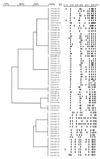Molecular typing of Penicillium marneffei isolates from Thailand by NotI macrorestriction and pulsed-field gel electrophoresis
- PMID: 11724880
- PMCID: PMC88584
- DOI: 10.1128/JCM.39.12.4544-4548.2001
Molecular typing of Penicillium marneffei isolates from Thailand by NotI macrorestriction and pulsed-field gel electrophoresis
Abstract
Penicillium marneffei is recognized as one of the most frequently detected opportunistic pathogens of AIDS patients in northern Thailand. We undertook a genomic epidemiology study of 64 P. marneffei isolates collected from immunosuppressed patients by pulsed-field gel electrophoresis (PFGE) with restriction enzyme NotI. Among the 69 isolates fingerprinted by PFGE, 17 were compared by HaeIII restriction endonuclease typing. The PFGE method demonstrated a higher degree of discriminatory power than restriction endonuclease typing with HaeII. Moreover, an impressive diversity of P. marneffei isolates was observed, as there were 54 distinct macrorestriction profiles among the 69 isolates of P. marneffei. These profiles were grouped into two large clusters by computer-assisted similarity analysis: macrorestriction pattern I (MPI) and MPII, with nine subprofiles (MPIa to MPIf and MPIIa to MPIIc). We observed no significant correlation between the macrorestriction patterns of the P. marneffei isolates and geographical region or specimen source. It is interesting that all isolates obtained before 1995 were MPI, and we found an increase in the incidence of infections with MPII isolates after 1995. We conclude that PFGE is a highly discriminatory typing method and is well suited for computer-assisted analysis. Together, PFGE and NotI macrorestriction allow reliable identification and epidemiological characterization of isolates as well as generate a manageable database that is convenient for expansion with information on additional P. marneffei isolates.
Figures


Similar articles
-
Nucleotide sequence-based analysis for determining the molecular epidemiology of Penicillium marneffei.J Clin Microbiol. 2006 Sep;44(9):3145-53. doi: 10.1128/JCM.00567-06. J Clin Microbiol. 2006. PMID: 16954240 Free PMC article.
-
Microsatellite analysis of clinical isolates of the opportunistic fungal pathogen Penicillium marneffei from AIDS patients in China.Scand J Infect Dis. 2011 Aug;43(8):616-24. doi: 10.3109/00365548.2011.559649. Epub 2011 Feb 18. Scand J Infect Dis. 2011. PMID: 21332284
-
A multilocus sequence typing system for Penicillium marneffei: an international molecular cyber system for tracking its origin and transmission.Hong Kong Med J. 2010;16(5 Suppl 4):45-6. Hong Kong Med J. 2010. PMID: 20864749 No abstract available.
-
Penicillium marneffei infection in patients infected with human immunodeficiency virus.Curr Top Med Mycol. 1997 Dec;8(1-2):35-42. Curr Top Med Mycol. 1997. PMID: 9504065 Review.
-
Penicillium marneffei: an insurgent species among the penicillia.J Eukaryot Microbiol. 2000 Jan-Feb;47(1):24-8. doi: 10.1111/j.1550-7408.2000.tb00006.x. J Eukaryot Microbiol. 2000. PMID: 10651292 Review.
Cited by
-
Penicillium marneffei infection and recent advances in the epidemiology and molecular biology aspects.Clin Microbiol Rev. 2006 Jan;19(1):95-110. doi: 10.1128/CMR.19.1.95-110.2006. Clin Microbiol Rev. 2006. PMID: 16418525 Free PMC article. Review.
-
Analysis of polymorphic microsatellite markers for typing Penicillium marneffei isolates.J Clin Microbiol. 2004 Apr;42(4):1483-90. doi: 10.1128/JCM.42.4.1483-1490.2004. J Clin Microbiol. 2004. PMID: 15070993 Free PMC article.
-
Nucleotide sequence-based analysis for determining the molecular epidemiology of Penicillium marneffei.J Clin Microbiol. 2006 Sep;44(9):3145-53. doi: 10.1128/JCM.00567-06. J Clin Microbiol. 2006. PMID: 16954240 Free PMC article.
-
Role of Cannomys badius as a natural animal host of Penicillium marneffei in India.J Clin Microbiol. 2004 Nov;42(11):5070-5. doi: 10.1128/JCM.42.11.5070-5075.2004. J Clin Microbiol. 2004. PMID: 15528698 Free PMC article.
-
MP1 homologue-based multilocus sequence system for typing the pathogenic fungus Penicillium marneffei: a novel approach using lineage-specific genes.J Clin Microbiol. 2007 Nov;45(11):3647-54. doi: 10.1128/JCM.00619-07. Epub 2007 Sep 19. J Clin Microbiol. 2007. PMID: 17881546 Free PMC article.
References
-
- Ajello L, Padhye A A, Sukroongreung S, Nilakul C H, Tantimavanich S. Occurrence of Penicillium marneffei infections among wild bamboo rats in Thailand. Mycopathologia. 1995;131:1–8. - PubMed
-
- Bostock A, Khattak M N, Matthews R, Burnie J. Comparison of PCR fingerprinting, by random amplification and polymorphic DNA, with other molecular typing methods for Candida albicans. J Gen Microbiol. 1993;139:2179–2184. - PubMed
-
- Chiewchanvit S, Mahanupab P, Hirunsri P, Vanittanakom N. Cutaneous manifestations of disseminated Penicillium marneffei mycosis in five HIV-infected patients. Mycoses. 1991;34:245–249. - PubMed
-
- Deng Z, Ribas J L, Gibson D W, Conner D H. Infectious caused by Penicillium marneffei in China and Southeast Asia: review of eighteen published cases and report of four more Chinese cases. Rev Infect Dis. 1998;10:640–652. - PubMed
-
- Dice L R. Measurement of the amount of ecological association between species. Ecology. 1945;26:297–302.
Publication types
MeSH terms
Substances
LinkOut - more resources
Full Text Sources
Medical

